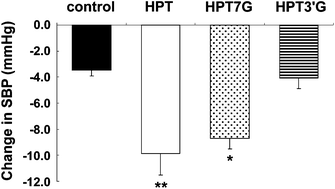Hesperidinmetabolite hesperetin-7-O-glucuronide, but not hesperetin-3′-O-glucuronide, exerts hypotensive, vasodilatory, and anti-inflammatory activities
Abstract
Orally ingested

* Corresponding authors
a
Biological Science Laboratories, Kao Corporation, 2606 Akabane Ichikai-machi, Haga-Gun Tochigi 321-3497, Japan
E-mail:
yamamoto.masaki@kao.co.jp
Fax: +81 285-68-7495
Tel: +81 285-68-7643
Orally ingested

 Please wait while we load your content...
Something went wrong. Try again?
Please wait while we load your content...
Something went wrong. Try again?
M. Yamamoto, H. Jokura, K. Hashizume, H. Ominami, Y. Shibuya, A. Suzuki, T. Hase and A. Shimotoyodome, Food Funct., 2013, 4, 1346 DOI: 10.1039/C3FO60030K
To request permission to reproduce material from this article, please go to the Copyright Clearance Center request page.
If you are an author contributing to an RSC publication, you do not need to request permission provided correct acknowledgement is given.
If you are the author of this article, you do not need to request permission to reproduce figures and diagrams provided correct acknowledgement is given. If you want to reproduce the whole article in a third-party publication (excluding your thesis/dissertation for which permission is not required) please go to the Copyright Clearance Center request page.
Read more about how to correctly acknowledge RSC content.
 Fetching data from CrossRef.
Fetching data from CrossRef.
This may take some time to load.
Loading related content
